Despite the defeat they experienced near Vienna, the Turks still managed to bounce back. King Jan III found out about it, who almost cost his life a dramatic clash with the young and energetic Pasha Kara Mehmed at Parkany.
The break-up of the Turkish army near Vienna on September 12, 1683, did not end Jan III Sobieski's campaign against the Ottomans. The Polish king intended to follow the blow, realizing that Turkey had not yet been finally defeated. The enemy troops were regrouping in the occupied territories of Hungary, and reinforcements could also be expected. This is why the monarch opted to continue the campaign by striking towards Buda.
Allied with John III, the Habsburgs, however, opted for a more modest plan, providing for an attack on the Turkish fortresses on the border between the Austrian and Ottoman parts of Hungary. It seems that the Austrians feared a sharp rise in Sobieski's position. If, in addition to the Viennese victory, the king added the reflection of the former capital of the Magyars from the hands of the Ottomans, he could be considered by them as a true providential man. For the Habsburgs, ruling the western and northern parts of the country, it would not be convenient.
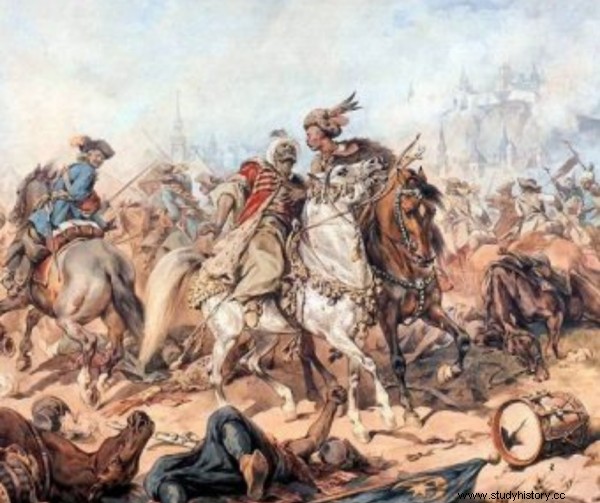
The Battle of Parkanami in the painting by Juliusz Kossak.
So the king had to relinquish eventually. The allies decided to lead the offensive to Nowe Zamki and Ostrzyhom. Meanwhile, intensive preparations for the next clash were already underway on the Turkish side. The grand vizier, Kara Mustafa, was gathering troops from Turkish fortresses in an attempt to rebuild the strength of his army. He acted in a hurry, wanting to rehabilitate himself as soon as possible. He knew that if he did not quickly cover the defeat at Vienna with some spectacular success, the angry Sultan would punish him with death. Earlier, in order to divert the accusations of disaster from himself, he had made several lesser commanders responsible, whom he had ordered, executed.
Nausea, vomiting, delirium
According to the adopted strategy, on September 18, 1683, the allied army set off towards the Habsburg-Ottoman border. The march was opened by 25,000 Poles, followed by 20,000 Austrian forces. For this time of year, the temperatures were very high, which made the march very difficult. The matter was made even worse by the lack of food and the epidemic of dysentery spreading in the wards.
“Almost half of the army suffers from such a disease, which is a plague similar to air. This fever is called Hungarian, like insides, with bloody dysentery, along with vomiting and nausea et le delire (ie delirium) "- Sobieski complained in one of the letters to his wife Marysieńka.
Having reached the border town of Komorn, a decision was made to attack the fortress in Esztergom. So the army turned towards the river Vah and started the crossing. Two bridges were used, but the passage of large masses of the army was dragged on. In the suburb, thousands of soldiers had to wait for their turn. Fortunately, scouts sent to the nearest larger town, Parkanów, reported that there were no major enemy troops nearby.
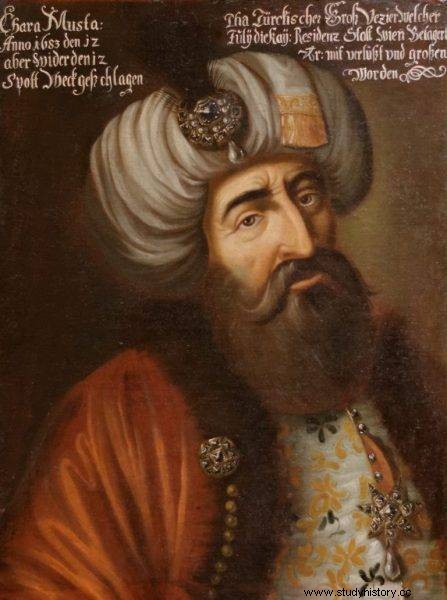
The grand vizier, Kara Mustafa, needed success in fighting the coalition. Otherwise, he knew the Sultan would condemn him to death.
On October 7, Polish troops completed the crossing. Sobieski immediately moved forward, not waiting for the imperial forces still crossing the river. He reached the plain in front of the Rooks, undulating with many hills and mounds. The commander of the Austrians, Prince Charles of Lorraine, sent a messenger to the king in an attempt to stop him. The winner from Vienna, however, ignored the warnings and continued walking along the Danube.
The vanguard of the Polish army was formed by the unit of the crown guard, Stefan Bidziński, numbering over a thousand soldiers. It consisted of dragoons and light riding. At one point, its members came across a small detachment of Turks and launched their attack. When the attacked followers of the Prophet began to flee towards Parkanów, Bidziński's cavalry followed them. There the Polish commander noticed suddenly that large Turkish forces were standing at the gates of a small fortress. After a while, Turkish cannons thundered from its ramparts. The Janissary infantry also fired a volley towards the Poles. The Dragons began dismounting and responding with musket fire, but fell heavily under the avalanche of Turkish bullets. The opponent had a huge advantage in numbers.
Is that Sobieski's head?
It turned out that Bidziński came across the entire Turkish army under the leadership of the young Pasha, Kara Mehmed, near Parkany. It numbered 15-20 thousand soldiers. That the Allied scouts had missed her march towards Esztergom and then Parkanów was hard to understand. Perhaps the reason was the overconfidence of some commanders who, after Vienna, found the enemy finally crashed and incapable of carrying out a larger operation.
The crown guard sent a messenger to the king, informing about the Turks and the pogrom of the vanguard. Sobieski picked up 4,000 rides and immediately headed towards Parkanów. Along the way, he encountered groups of survivors fleeing in the opposite direction. Realizing that he had a large army of the enemy ahead of him, he stopped the ride and set it up in defensive formation. He wanted to wait for the infantry and artillery that were left behind to approach. Unfortunately, the position taken by the Polish cavalry was not very convenient, and panic began to burst into its ranks. The Dragons, a formation that moved on horseback but fought on foot, even refused to dismount at first!
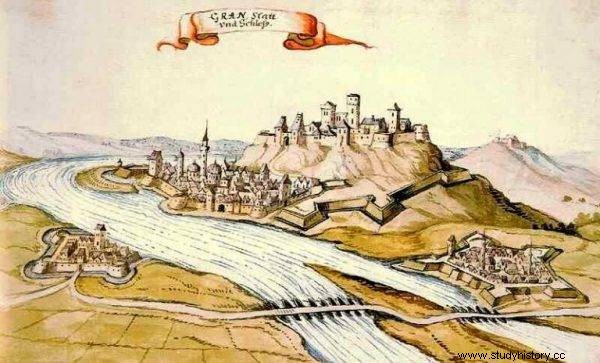
Fences (on the left side of the river) and Esztergom on the 17th-century drawing.
Kara Mehmed quickly realized that the Polish forces were lean, devoid of infantry support and easy to encircle. He gave the cavalry an order to attack. Leaning the lances, the Turkish riders - spahisi - rushed towards the Polish left wing. The attack, however, was unsuccessful; repulsed by hussars and armored Turks had to escape.
Immediately, however, more waves of mustachioed riders in cones - this time on the right wing - started their assault. A fierce fight took place there, in which, among others, the voivode of Pomerania, Denhoff, fell. Due to his considerable body weight, the Turks mistook him for Sobieski himself. They fell into euphoria. The voivode's severed head, impressed on the copy, appeared above the Turkish arrays. Despite heavy losses, the Poles commanded by Hetman Stanisław Jabłonowski did not give way, bravely defending themselves. Their enemies fought for a time, then suddenly turned their steeds back on a signal and handed over their rear.
Poles trapped
Even though Sobieski firmly forbade his men to counterattack, after the retreat of the Turks on the right wing, the Poles, heated by the battle, chased the enemy. They were thus drawn into a deadly trap. Jabłonowski's riders chased after the enemy in complete disorder, without maintaining their formation.
Kara Mehmed was just waiting for it. At one point, the escaping Ottoman cavalrymen abruptly turned back and, screaming, plunged into the completely surprised pursuers. After a while, the hussar steeds fell pierced with lances, and the riders died from the blows of sabers and ice axes. In the blink of an eye, the Polish right wing was disorganized and shattered.
Pasha in flight seized the opportunity. He wanted to use the resulting gap to encircle the remaining enemy forces. Thousands of spahis galloped forward, trying to bypass the Polish center and get to its rear. Banners embroidered with the suras of the Koran proudly fluttered over the Turks' heads.
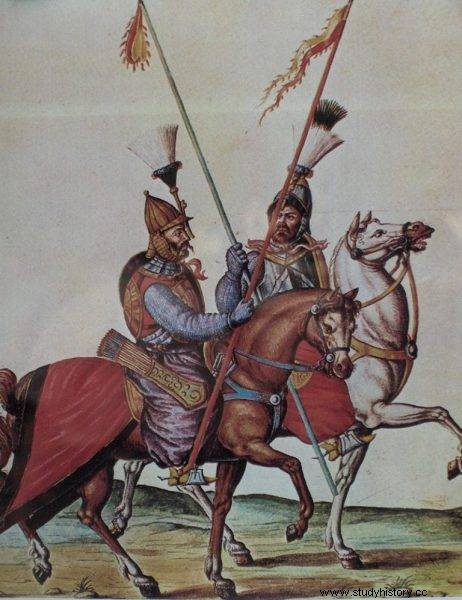
Drawing of spahis from the Battle of Parkany period.
Sobieski saw the threat and reacted quickly. He ordered several Hussar banners to turn sharply to the right, towards the wave of Ottoman riders rushing there. In the chaos that prevailed around, this maneuver was, however, misunderstood by other Polish troops. The armored and dragoons decided that the hussars, turning violently, took their legs by the belt and did the same without hesitation. After a while, the entire Polish cavalry, including the hussars, fled in complete disarray towards the west. In the crowd, the riders pounced on one another, pounced on their horses and trampled.
Meanwhile, the victorious Turks chased the Poles on their small but quick mounts. Anyone who escaped too slowly was killed by the blows of Ottoman sabers and maces. At some point, two spahis began to catch up with the king himself, who was escaping in a group of several soldiers. When they were about to punch, one of the reiters jumped in to help Jan III. He knocked one Turk down with a pistol shot, then clashed with the other, knocking him off his horse with a rapier's blow. After a while he died, surrounded by enemies.
Thanks to his sacrifice, Sobieski managed to break out of the pursuit. Soon he saw a line of Habsburg infantry in the distance. He was saved!
Charge after charge
Seeing the main Austrian and Polish forces ahead, the Turks stopped their attack and retreated. Kara Mehmed was overjoyed anyway. He finally managed to beat up the Lion of Lechistan.
The Polish king wanted to start a counterattack immediately, but Charles of Lorraine managed to dissuade him from doing so. Dusk was approaching, and many of the troops that had just crossed the river were not yet ready to fight. So it was agreed that the army would spend the night in the camp, rest the next day, and start the action only a day later.
There were gloomy moods among Poles. Most of the commanders were reluctant to continue the fight. Nevertheless, Sobieski was bitter, wanting to take revenge for his failure as soon as possible. He was certainly aware of his strengths, above all the numerical advantage of the entire Polish-Austrian forces over his opponent.
On the morning of October 9, the Allied army marched out of the camp and lined up in front of the Turkish forces at Parkany. Winged by the previous victory, Kara Mehmed believed that he had broken the enemy's morale and would now take him down to the rest. Around 12.30 p.m., the battle began. He ordered the cavalry to attack the center of the enemy forces, which was mainly composed of ranks of Austrian musketeers and artillery.
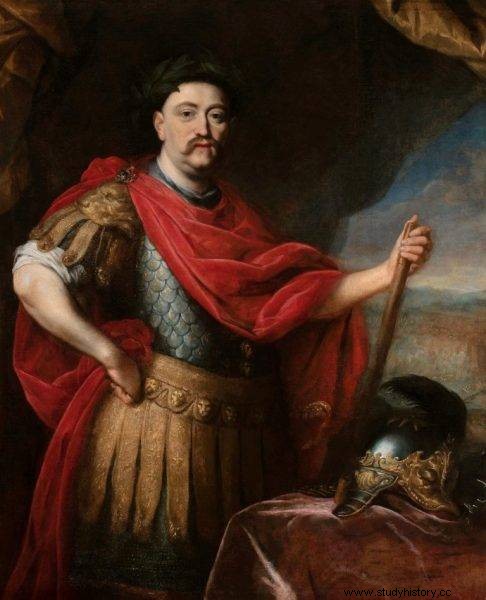
Irritated by the defeat, Sobieski wanted to retaliate against the Turks as soon as possible. Charles of Lorraine, however, persuaded him to wait.
Imperial guns rang out. The bullets made bloody gaps in the mass of the advancing riders. Hundreds of muskets thundered as the Spahis came within 250 meters. The front ranks of the Turks fell in a row, turning into a mulch of wounded screaming people and snarling mounts. The rest turned their steeds and handed over the rear.
Now it is time for the left wing, commanded by Hetman Jabłonowski. The Ottoman cavalry attacked there with great force, taking advantage of the slope of the terrain, and clashed with the Polish hussars. The fear of sabers, broadswords and koncerze began. The latter were especially useful for Poles. The long, straight and sword-like weapon easily pierced the weak Turkish cuirass and chain mail. The enemies, however, fought extremely ferociously, as if certain that they would repeat the success of two days ago. Therefore, Kara Mehmed, who was observing the battlefield, decided that it was in this section that he had the best chance of breaking the enemy's ranks. So he suddenly sent the cavalry units from the center against Jabłonowski as well.
Relief of cuirassiers
Fortunately, the conscious Prince Charles of Lorraine did not leave the Poles alone. He threw 2,000 of his cuirassiers to help them. The Austrian heavy cavalry accelerated and attacked the charging Turks from the side. A tactic called caracol was used:the first row of riders fired their pistols at the enemy, then slowed down, moving to the end of the formation. He was immediately replaced by another who was also firing and retreating.
When the Turks, decimated by fire, were close, the cuirassiers drew rapiers and engaged them in hand-to-hand combat. Shielded with plate armor and helmets, they were also a formidable opponent in direct combat. Eventually the attack broke down, bringing heavy losses to the Turks.
Thanks to the Austrians, Jabłonowski's banners gained a moment of breathing, after which they began a counterattack. A bench of winged riders crushed the Turkish cavalry and set off in pursuit of the flocks of refugees. Units of armored and imperial cuirassiers ran alongside the hussars. Soon after, the shocked Turkish leader noticed that in the place where he wanted to breach his forces, his forces were crushed.
He still had a reserve, so he began to throw more troops to stop the waves of enemy cavalry breaking into the Turkish right wing. But nothing could stop the allied mass of riders. Turks fell like flies, pierced by lances and rapiers, slashed with sabers, trampled with horse hooves.
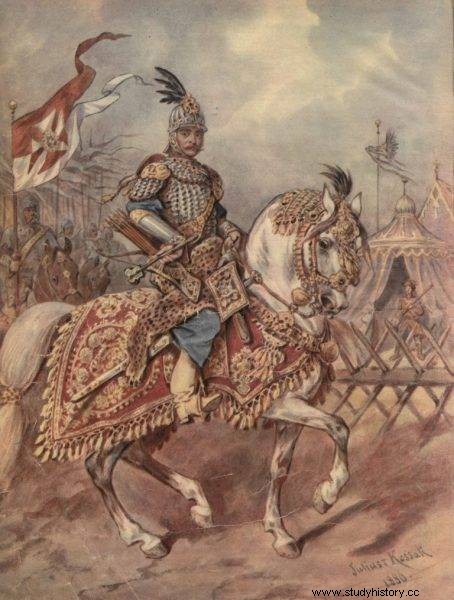
Captain of the armored banner in the painting by Juliusz Kossak.
Seeing that Kara Mehmed's army was collapsing, Sobieski also launched an attack on the right flank, closer to the Danube. Turkish forces broke there very quickly under the pressure of Polish and Imperial cavalry, and the Sultan's soldiers began to retreat in a panic. Pasha realized that the enemy was gripping his troops from both sides, and signaled to retreat, although his subordinates no longer needed any orders:they fled all the way.
He himself, with a head wound, reached the Danube bridge and managed to gallop along it along with about a thousand soldiers. He made it almost at the last moment, because the bridge, already bombarded by Polish artillery, finally collapsed under the weight of the mass of Turkish refugees. Hundreds of unfortunates found themselves in the river, while thousands of their companions, who had not made it to the crossing, swarmed on the shore, attacked from all sides by Austrians and Poles.
The slaughter of the desperately defending Turks lasted for about 2 hours. Around 5 p.m. it was all over:in the field strewn with thousands of corpses, the remains of the Janissaries surrendered to the victors. Kara Mehmed's army ceased to exist.
Twilight of Turkey and .. Poland
In the second, victorious Battle of Parkany for the Allies, about 10,000 Turks and about 1,000 soldiers of the allied army were killed. Then, the Polish-Austrian forces, as previously planned, headed for Esztergom and captured it after a short siege.
The Park Battle of October 9, 1683 sealed the fall of the Ottoman military power, which was never reborn. Habsburg Austria mainly benefited from the Turkish defeat, winning Buda and Transylvania in the following years. The Republic, on the other hand, regained part of Ukraine from the Turks, including Kamieniec Podolski, but left the war completely exhausted.
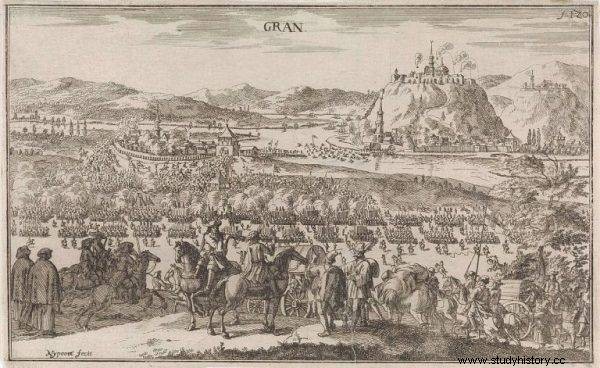
17th century depiction of the Battle of Parkany.
As a result, its position among the countries of Central and Eastern Europe has shaken. At the beginning of the 18th century, the former regional power was just a colossus on clay feet, the object of games played by stronger neighbors. The victories at Vienna and Parkany turned out to be the last glimpse of the power of the collapsing Republic of Poland.
